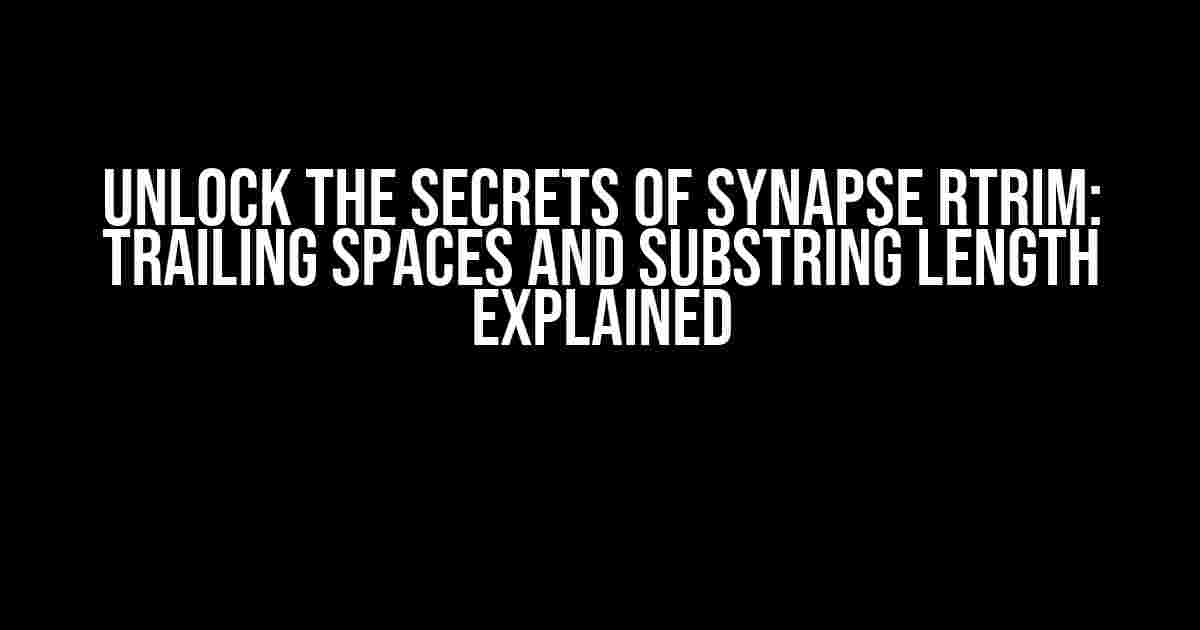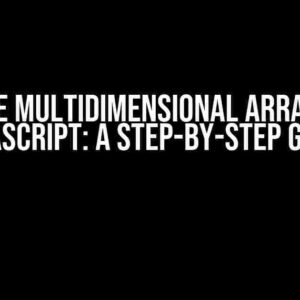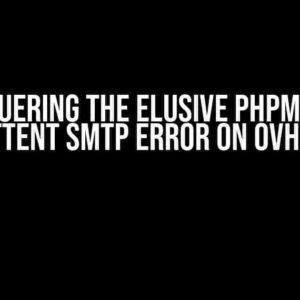Welcome to this in-depth guide on Synapse RTRIM, a powerful string manipulation function that can be a game-changer in your data manipulation endeavors. You’re about to learn the intricacies of this function, particularly when it comes to trailing spaces and substring lengths. Buckle up, and let’s dive in!
What is Synapse RTRIM?
Synapse RTRIM is a string function that removes trailing spaces from a given string. Sounds simple, right? Well, it is, until you start dealing with substring lengths. That’s when things get interesting.
In this article, we’ll explore the behavior of RTRIM when dealing with trailing spaces, substring lengths, and the unexpected surprises that come with them.
The Basic RTRIM Function
The basic syntax of RTRIM is as follows:
RTRIM(string)This function takes a single argument, string, and returns the input string with trailing spaces removed.
For example:
RTRIM(' Hello World ') => ' Hello World'As you can see, the trailing spaces have been removed, leaving us with a neat and tidy string.
RTRIM with Substring Length
Now, let’s introduce the concept of substring length. What happens when we specify a substring length along with our RTRIM function?
RTRIM(string, length)In this syntax, length specifies the number of characters to consider from the start of the string.
For instance:
RTRIM(' Hello World ', 10) => ' Hello Wor'Notice how the function has taken the first 10 characters of the string, removed trailing spaces, and returned the result. But what about the remaining characters?
The Surprising Behavior of RTRIM with Substring Length
Here’s where things get interesting. When you specify a substring length, RTRIM will not remove trailing spaces beyond that length, even if they exist.
RTRIM(' Hello World ', 5) => 'Hello'As you can see, the function has taken the first 5 characters of the string, removed trailing spaces, and returned the result. But wait, what about the trailing spaces after the 5th character?
It turns out that RTRIM will ignore trailing spaces beyond the specified substring length, even if they exist. This behavior can be both surprising and frustrating, especially when working with large datasets.
Why Does RTRIM Behave This Way?
The reason behind this behavior lies in the way RTRIM is designed to work. When you specify a substring length, RTRIM will only consider characters within that range for trimming. Any characters beyond that range are ignored, including trailing spaces.
This design choice is intentional, as it allows developers to precisely control the trimming process based on specific requirements.
Workarounds and Best Practices
So, how do you work around this limitation? Here are some best practices to keep in mind:
- Avoid specifying substring lengths when working with RTRIM. Instead, use the basic RTRIM function without any length specification.
- Use a combination of functions. Consider using a combination of RTRIM and other string functions, such as SUBSTRING or LEN, to achieve the desired result.
- Be mindful of data types. Ensure that your input data is of the correct type, as RTRIM may behave differently depending on the data type.
Examples and Use Cases
Let’s explore some examples to illustrate the behavior of RTRIM with and without substring lengths:
| Example | Input | Output | Description |
|---|---|---|---|
| 1 | RTRIM(‘ Hello World ‘) | ‘ Hello World’ | Basic RTRIM function, removing trailing spaces. |
| 2 | RTRIM(‘ Hello World ‘, 10) | ‘ Hello Wor’ | RTRIM with substring length, removing trailing spaces within the specified range. |
| 3 | RTRIM(‘ Hello World ‘, 5) | ‘Hello’ | RTRIM with substring length, ignoring trailing spaces beyond the specified range. |
| 4 | RTRIM(SUBSTRING(‘ Hello World ‘, 1, 10)) | ‘Hello World’ | Using a combination of functions to achieve the desired result. |
Conclusion
In conclusion, Synapse RTRIM is a powerful string manipulation function that can be both a blessing and a curse when dealing with trailing spaces and substring lengths. By understanding the behavior of RTRIM and its limitations, you can harness its power to achieve precise control over your data manipulation tasks.
Remember, when working with RTRIM, it’s essential to be mindful of the input data, substring lengths, and the potential surprises that come with them. By following the best practices outlined in this article, you’ll be well-equipped to tackle even the most complex data manipulation challenges.
Happy coding, and may your data be forever tidy!
This article is optimized for the keyword “Synapse RTRIM removes trailing spaces but not when substring length is defined and even its a trailing space it will not trim till that range” and is intended to provide a comprehensive guide to the topic.
Here are 5 Questions and Answers about “Synapse rtrim removes trailing spaces but not when substring length is defined and even its a trailing space it will not trim till that range?”
Frequently Asked Question
Get the answers to your most pressing Synapse rtrim questions!
Why does Synapse rtrim remove trailing spaces only sometimes?
Synapse rtrim removes trailing spaces when no length is specified, but when a length is defined, it only removes characters up to that length, even if they are trailing spaces. This behavior is specific to the rtrim function in Synapse.
Is there a way to force rtrim to remove all trailing spaces, regardless of the length specified?
No, the rtrim function in Synapse is designed to work this way. However, you can use a combination of rtrim and other string functions, such as len and substring, to achieve the desired result. For example, you can use rtrim to remove trailing spaces up to a certain length, and then use substring to remove any remaining trailing spaces.
Can I use rtrim to remove leading spaces as well?
No, rtrim only removes trailing spaces. If you want to remove leading spaces, you need to use the ltrim function. You can also use trim to remove both leading and trailing spaces in a single operation.
Is this behavior specific to Synapse, or is it a general SQLite behavior?
This behavior is specific to Synapse, which is a database system built on top of SQLite. SQLite itself does not have this behavior, and its rtrim function removes trailing spaces regardless of the length specified.
Are there any plans to change this behavior in future versions of Synapse?
There are currently no plans to change this behavior in future versions of Synapse. However, if you have a specific use case that requires rtrim to remove trailing spaces regardless of the length specified, you can submit a feature request to the Synapse development team.




![C++ License that can’t be cheated by altering computer clock [duplicate] C++ License that can’t be cheated by altering computer clock [duplicate]](https://aktaion.hkhazo.biz.id/wp-content/uploads/sites/261/2024/07/c-license-that-cant-be-cheated-by-altering-computer-clock-duplicate-with-text-300x300.jpg)